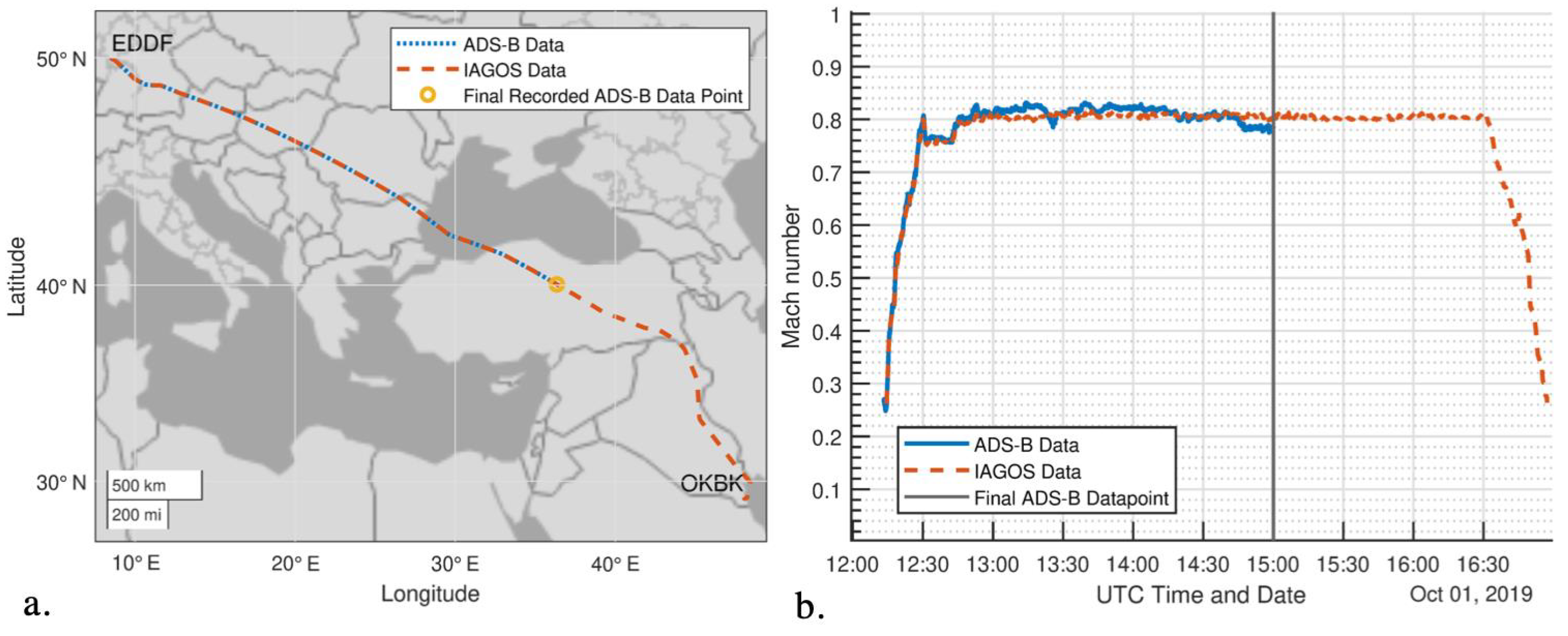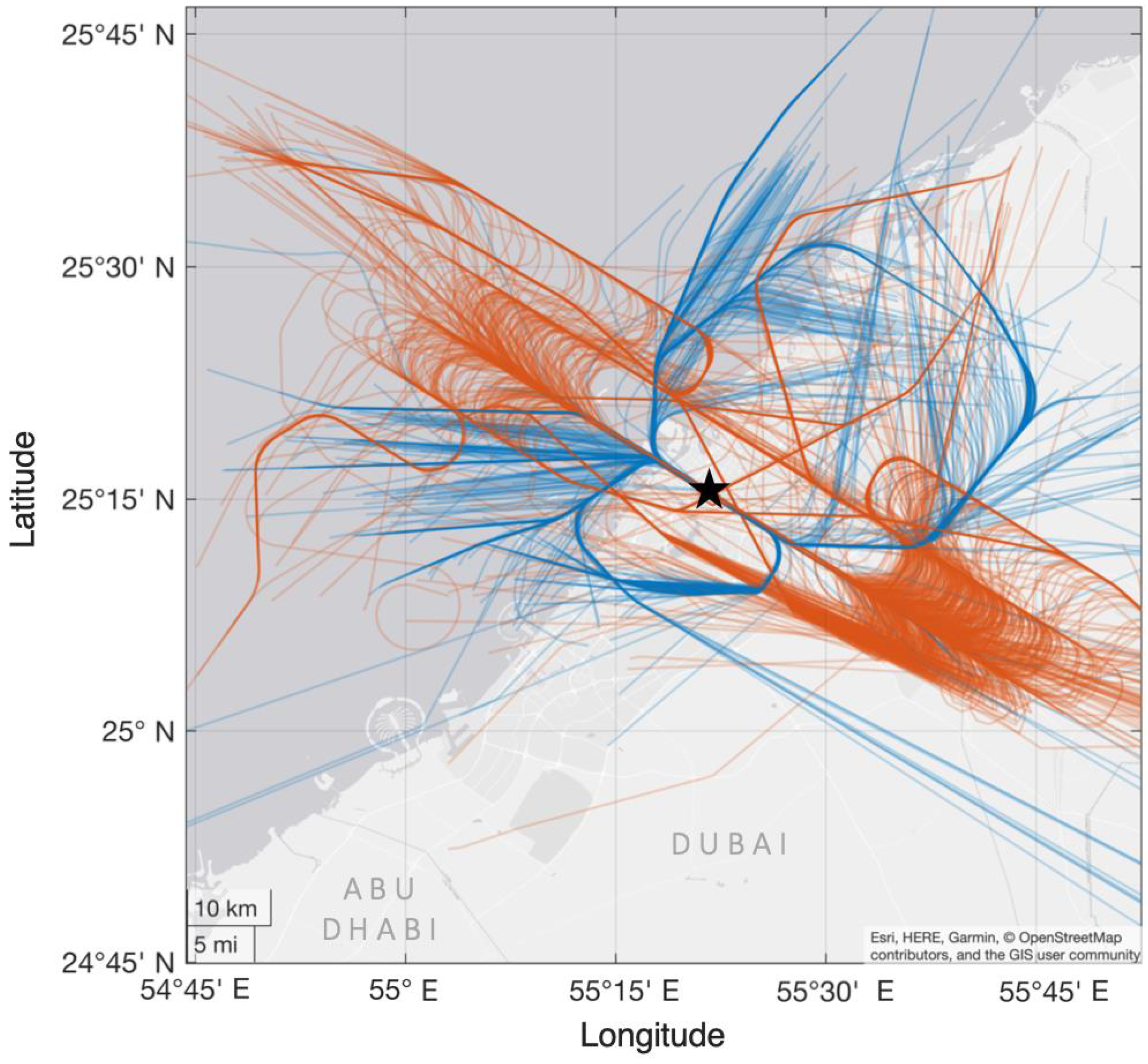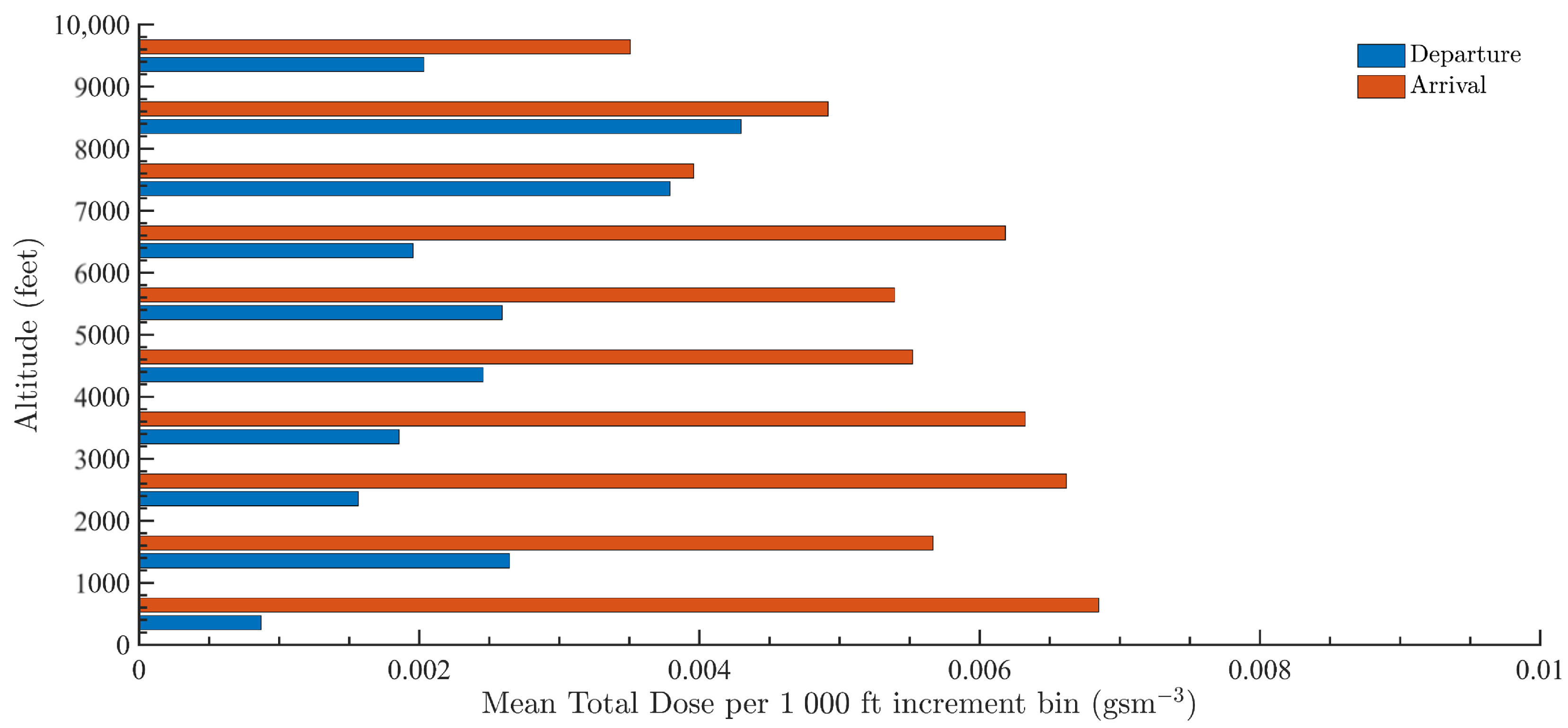Terminal Manoeuvre Area Effects on Aircraft Engine Dust Ingestion †
Abstract
:1. Introduction
- Dust or Sand storm is observed at least once in the 24-h period.
- 25% of the daily observations of visibility indicate suspended dust.
2. Materials and Methods
2.1. Trajectory and Fleet Data
- International Civil Aviation Organization 24 bit identifier for aircraft (Hexcode)
- Latitude
- Longitude
- Ground Speed (GS)
- Altitude (Barometric)
- exceeds known aircraft limits
- 2000 feet
- ADS-B consecutive data point time gap min
2.2. Weather Reanalysis Model
- 0.030–0.550 m
- 0.550–0.900 m
- 0.900–20.000 m
3. Theory & Calculations
3.1. Dust Exposure Dose
3.2. Verification Study
3.3. Spurious Dose Filter
4. Results and Discussion
4.1. Fleet Analysis
4.2. Mean Dose Levels
4.3. Effect of Runway Direction
4.4. Altitudinal Variation in Dose
5. Conclusions
Author Contributions
Funding
Data Availability Statement
Acknowledgments
Conflicts of Interest
Abbreviations
| ADS-B | Automatic Dependent Surveillance-Broadcast |
| ECMWF | European Centre for Medium-Range Weather Forecasts |
| CAMS | Copernicus Atmosphere Monitoring Service |
| FDR | Flight Data Recorder |
| GS | Groundspeed |
| IAGOS | In-service Aircraft Global Observing System |
| IATA | International Air Transport Association |
| ICAO | International Civil Aviation Organization |
| LCC | Low-cost Carrier |
| OSN | Open-Sky Network |
| SSR | Secondary Surveillance Radar |
| TAS | True Airspeed |
References
- Bojdo, N.; Filippone, A.; Parkes, B.; Clarkson, R. Aircraft engine dust ingestion following sand storms. Aerosp. Sci. Technol. 2020, 106, 106072. [Google Scholar] [CrossRef]
- Lancaster, N. SEDIMENTARY PROCESSES|Aeolian Processes. In Encyclopedia of Geology; Academic Press: Cambridge, MA, USA, 2005; p. 616. [Google Scholar] [CrossRef]
- Notaro, M.; Yu, Y.; Kalashnikova, O.V. Regime shift in Arabian dust activity, triggered by persistent Fertile Crescent drought. J. Geophys. Res. Atmos. 2015, 120, 10229–10249. [Google Scholar] [CrossRef]
- Schäfer, M.; Strohmeier, M.; Lenders, V.; Martinovic, I.; Wilhelm, M. Bringing up OpenSky: A large-scale ADS-B sensor network for research. In Proceedings of the 13th International Symposium on Information Processing in Sensor Networks (Part of CPS Week), Berlin, Germany, 15–17 April 2014; IPSN 2014. pp. 83–94. [Google Scholar] [CrossRef]
- Olive, X. Traffic, a toolbox for processing and analysing air traffic data. J. Open Source Softw. 2019, 4, 1518. [Google Scholar] [CrossRef] [Green Version]
- Clarkson, R.J.; Majewicz, E.J.; Mack, P. A re-evaluation of the 2010 quantitative understanding of the effects volcanic ash has on gas turbine engines. Proc. Inst. Mech. Eng. Part G J. Aerosp. Eng. 2016, 230, 2274–2291. [Google Scholar] [CrossRef]
- Petzold, A.; Thouret, V.; Gerbig, C.; Zahn, A.; Brenninkmeijer, C.A.M.; Gallagher, M.; Hermann, M.; Pontaud, M.; Ziereis, H.; Boulanger, D.; et al. Global-scale atmosphere monitoring by in-service aircraft—Current achievements and future prospects of the European Research Infrastructure IAGOS. Tellus B Chem. Phys. Meteorol. 2015, 67, 28452. [Google Scholar] [CrossRef] [Green Version]
- Ali, B.S.; Schuster, W.; Ochieng, W.Y. Evaluation of the Capability of Automatic Dependent Surveillance Broadcast to Meet the Requirements of Future Airborne Surveillance Applications. J. Navig. 2017, 70, 49–66. [Google Scholar] [CrossRef] [Green Version]
- Shao, Y.; Yang, Y.; Wang, J.; Song, Z.; Leslie, L.; Dong, C.; Zhang, Z.; Lin, Z.; Yutaka, K.; Yabuki, S.; et al. Northeast Asian dust storms: Real-time numerical prediction and validation. J. Geophys. Res. Atmos. 2003, 108, 2003JD003667. [Google Scholar] [CrossRef]





| Aircraft Type | ICAO Type Code | IATA Type Code | Number in Fleet (2019) |
|---|---|---|---|
| Boeing 737-800 (WL) 1 | B738 | 73H | 51 |
| Boeing 737 Max 8 | B38M | 7M8 | 10 |
| Category | % Total Flights | Mean Dose, g s m | Std. Dev., g s m |
|---|---|---|---|
| Arrivals | 50.9% | 0.0548 | 0.0550 |
| Departures | 49.1% | 0.0170 | 0.0178 |
| Runway 12 L/R | 68.1% | 0.0606 | 0.0539 |
| Runway 30 L/R | 27.2% | 0.0274 | 0.0382 |
| Unclassified | 4.7% | ||
| Overall | 100% | 0.0396 | 0.0765 |
Disclaimer/Publisher’s Note: The statements, opinions and data contained in all publications are solely those of the individual author(s) and contributor(s) and not of MDPI and/or the editor(s). MDPI and/or the editor(s) disclaim responsibility for any injury to people or property resulting from any ideas, methods, instructions or products referred to in the content. |
© 2022 by the authors. Licensee MDPI, Basel, Switzerland. This article is an open access article distributed under the terms and conditions of the Creative Commons Attribution (CC BY) license (https://creativecommons.org/licenses/by/4.0/).
Share and Cite
Rotherham, D.; Bojdo, N.; Filippone, A.; Parkes, B. Terminal Manoeuvre Area Effects on Aircraft Engine Dust Ingestion. Eng. Proc. 2022, 28, 11. https://doi.org/10.3390/engproc2022028011
Rotherham D, Bojdo N, Filippone A, Parkes B. Terminal Manoeuvre Area Effects on Aircraft Engine Dust Ingestion. Engineering Proceedings. 2022; 28(1):11. https://doi.org/10.3390/engproc2022028011
Chicago/Turabian StyleRotherham, Daniel, Nicholas Bojdo, Antonio Filippone, and Ben Parkes. 2022. "Terminal Manoeuvre Area Effects on Aircraft Engine Dust Ingestion" Engineering Proceedings 28, no. 1: 11. https://doi.org/10.3390/engproc2022028011
APA StyleRotherham, D., Bojdo, N., Filippone, A., & Parkes, B. (2022). Terminal Manoeuvre Area Effects on Aircraft Engine Dust Ingestion. Engineering Proceedings, 28(1), 11. https://doi.org/10.3390/engproc2022028011






